Ariobarzanes (2)
Ariobarzanes (Old Persian: *Ariyabrdna) (†330): Persian nobleman, satrap of Persis, defended the Persian gate against Alexander the Great.
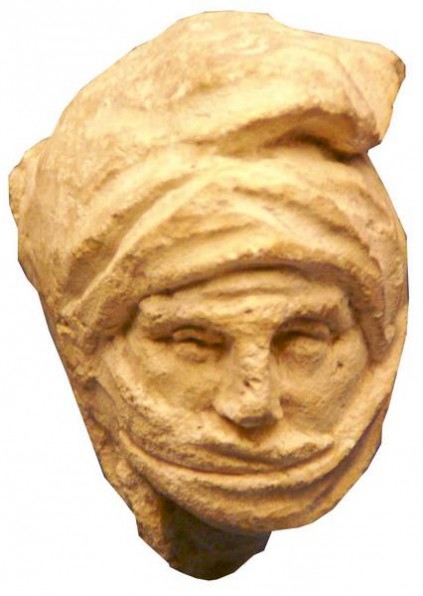
Ariobarzanes is best known as the satrap of Persis who was almost able to defeat the Macedonian conqueror Alexander the Great at the Persian gate, but before his day of fame, he had already earned his spurs. During the battle of Gaugamela (1 October 331), he had commanded a regiment of soldiers recruited along the Persian Gulf. It is not entirely clear what kind of people they may have been, but it is not surprising to find the satrap of Persis as commander of these people, because Persis is situated north of the Gulf.
It is more surprising that the Achaemenid king Darius III Codomannus had appointed a satrap for Persis. It seems that previously, this office had not existed, and it is possible that Darius, who had come to power in a period of great confusion, needed a reliable man at home while he was away, fighting against the Macedonians at Issus and Gaugamela. If this is correct, Ariobarzanes must have been a close relative or personal friend of Darius.
The Persians fought bravely at Issus and Gaugamela, but were unable to prevent Macedonian victories, and Alexander proceeded to Babylon and Susa. A royal road connected the last-mentioned city with the capitals of Persis, Persepolis and Pasargadae. Meanwhile, Darius was building a new army at Ecbatana.
It was obvious that Alexander wanted to reach the treasures of Persepolis before Darius could defend them. Ariobarzanes had to prevent the Macedonian attack on Persis, and had two advantages: in the first place, he commanded people who were defending their homes and were very motivated; in the second place, he knew the terrain. There were only a few possible roads through the Zagros mountains, which were now, in January 330, covered with snow and ice. And Ariobarzanes knew how to exploit this.
When Alexander invaded an unknown country, he usually divided his forces to diminish the risks and facilitate the food supply. Ariobarzanes must have learned from his spies that in the area of Masjid-e Solaiman, the Macedonian army had been split into two parts. Alexander's general Parmenion took one half along the Royal road, and the king himself took a more northern route. Ariobarzanes now knew where he could trap his main opponent: in the Persian Gate, northeast of modern Yasuj. When he had defeated Alexander, he could turn to the south and attack Parmenion.
At this point, we must briefly pause for a hypothesis. It would be irresponsible if Ariobarzanes would have left the Royal Road unguarded. We do not know for certain whether Parmenion encountered resistance, but it is likely. From the Persepolis fortification tablets, we know that under normal circumstances, he could have covered the entire distance from Susa to Persepolis in about three weeks. However, we know that he needed more time, which suggests that he had to fight against an army that is not mentioned in our sources, which focus on Alexander. We'll return to thus "unknown army" below.
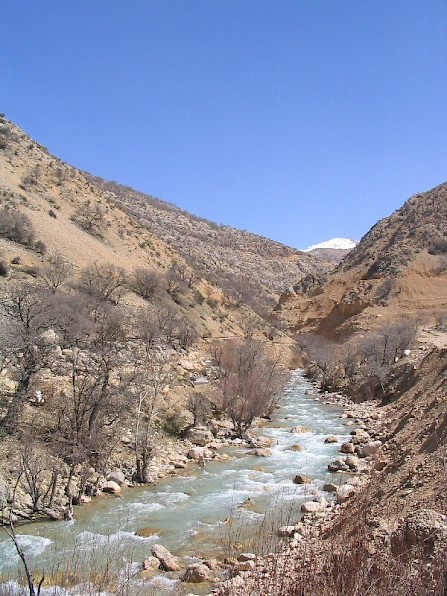
For Ariobarzanes, the young Macedonian king was the best of all possible enemies. He first massacred the mountain tribe of the Uxians, and believed that after this deed, everyone would flee. Indeed, at the Susian Gate, west of Yasuj, no one appeared to block the road. Believing that he would not encounter any problems in the Persian Gate either, Alexander forgot to send scouts into the pass and walked into Ariobarzanes' trap with his eyes wide open.
The satrap had occupied a position near the little village that is now known as Cheshmeh chenar. When one approaches this place from the west, the valley, called Tang-e Meyran, is initially very wide, so the Macedonians marched at some speed. But Ariobarzanes knew what he was doing. After an hour's walk, the valley becomes narrower, and curves to the east-southeast, where the Macedonians were blinded by the morning sun. Immediately after they had crossed an icy brook, the would had to turn to the left, where Ariobarzanes was ready to strike against an army that was standing on slippery ground, pushed forward by its rearguard, and under attack from all hilltops.
Our sources mention that Ariobarzanes had built a wall across the canyon, but he probably did not have to. The Persian Gate was only a couple of meters wide. However this may be, at some point, the first Macedonians must have realized that they could no longer advance, understood that they were ambushed, and hesitated. This was the moment Ariobarzanes had been waiting for. One signal was sufficient to convert the valley into a killing zone.
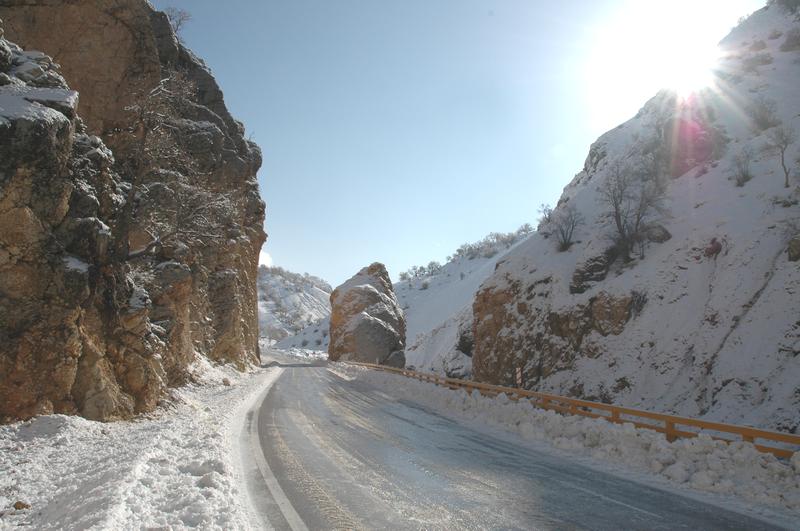
From the northern slope, the Persians mercilessly rained down boulders and stones on the Macedonians, who were smashed away not individually, but by entire platoons. From the southern slope, Persian archers and catapults launched their projectiles. The Macedonians panicked, tried to return, but were unable to do so, because their rear guard was still advancing. It must have taken some time before Alexander's men were in full retreat. The casualties were left behind.
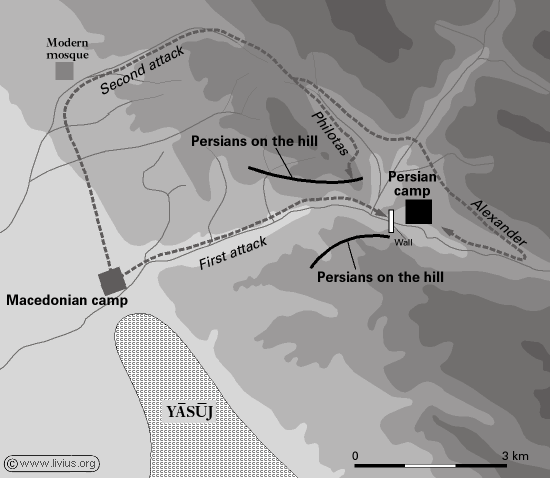
Ariobarzanes knew that the battle was not over yet. It was tempting to leave his position, advance to the west, and attack Alexander under cover of the night, but he knew that on the plains north of Yasuj, the professional Macedonian infantry could not be surprised. It was likely that Alexander would try again next day, or would try to take another road. This, however, would be dangerous. From Yasuj, the Macedonians could go to the north, to Gabae (modern Isfahan), where they would trap themselves between the army of Darius in Ecbatana and that of Ariobarzanes in Persis. Alternatively, they could go to the south and join Parmenion, trapping themselves between Ariobarzanes and the hypothetical unknown army (above). Given these facts, the Persians had some reason to believe that their success could change the course of the war. Alexander could not move to the north or south, but would have to retreat or try for a second time.
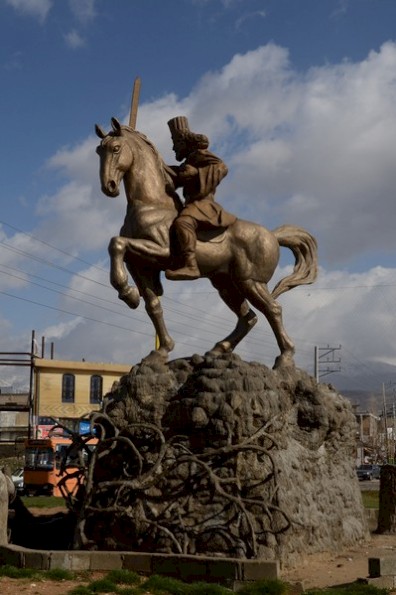
At this point, our sources tell an implausible anecdote: a local guide offered his services to the invaders, and told them how to turn the Persian Gate. This looks suspiciously like Herodotus' story of Ephialtes, who showed the Persian king Xerxes a road to circumvent Thermopylae in 480. Perhaps we better ignore this piece of information; after all, there is no mountain pass that cannot be turned. However this may be, Alexander discovered an accessible mountain path, and at dawn, Ariobarzanes was under attack from the north (by Philotas), from the east (by Alexander), and from the west (by Craterus).
Many Persians were massacred. Ariobarzanes managed to escape, but when he reached Persepolis, he was denied entrance to the city. The commander of the city's garrison had already learned the outcome of the battle, and was convinced that Alexander was invincible. No one needed Ariobarzanes alive; he was probably killed by the Macedonians.
Alexander reached the beautiful palace on one of the last days of January 330. He appointed a man named Phrasaortes as successor of Ariobarzanes, needed hundreds of dromedaries to carry away the treasure, and sacked the city in May 330.